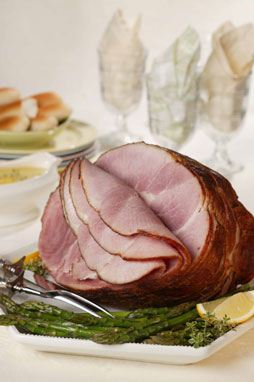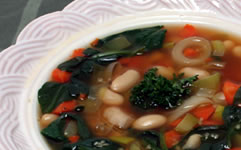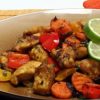Along with pastel-colored eggs and baskets of goodies, Easter in America has always meant ham. But aside from upholding tradition, there are many reasons for making ham the centerpiece of your holiday table this year.
Ham is a food-lover’s favorite. Its mildly sweet, smoky taste complements many other flavors.
Perhaps because it is so tasty and versatile, many cooks (and would-be cooks) lose sight of ham’s biggest asset: it’s easy to prepare.
“Most people think of holiday meal preparation as a complicated, day-long process, and maybe with the Thanksgiving bird that’s true. But preparing a ham is a breeze,” says Ceci Snyder, M.S., R.D., Director of Nutrition Communications for the Pork Information Bureau for the National Pork Board. “It’s precooked so it just needs heating up. Even novice cooks, who are often intimidated by a `hunk of meat,’ can fix a ham.”
And, as if taste and ease of preparation aren’t enough, cooks and “eaters” alike may be surprised to find that ham is low in fat and calories.
“Because ham is so delightfully tasty, many people assume it’s high in fat,” says Snyder. “But the great news is that it’s very lean — a great Easter treat.”
In fact, a 3-ounce serving of extra-lean ham has only 116 calories and 4.1 grams of fat.
Rules of Thumb
To ensure the perfect Easter dinner, Snyder offers some simple tips for selecting, storing and preparing ham.
How much ham is enough?
When serving boneless ham, plan on four to five servings per pound. Count on two to three servings per pound with a bone-in ham. For the dollar-conscious cook, the boneless ham delivers superior value, according to Snyder, and also offers hassle-free carving.
Not too cold, not too hot
Don’t freeze a ham before you use it – refrigerate instead. Both bone-in and boneless hams, in their original packaging, will keep several weeks in the refrigerator.
Is the ham done yet?
Virtually all hams on the market today are precooked, so they only need to be reheated to an internal temperature of 140 degrees F. for serving.
An uncooked ham will be labeled “cook before eating” and requires an internal temperature of 160 degrees F. for doneness.
If you don’t have a meat thermometer, you can generally plan on cooking an uncooked ham 30 minutes per pound.
For a precooked ham, just follow the directions on the label, and heat in a moderate (325 – 350 degrees F.) oven.
How long to keep leftovers?
Refrigerate a ham within two hours of serving and you can enjoy the leftovers for up to five days.
Time Is On Your Side
Unlike Thanksgiving, when preparation centers on the bird, the easy elegance of ham provides extra time for cooks to jazz up their Easter side dishes. Try familiar spring flavors and ingredients in new combinations.
“And just as grandma’s gravy is the perfect accompaniment to turkey,” Snyder adds, “let a delicious fruit chutney complement your Easter ham.”
Browse our collection of Easter recipes here: Diabetic Easter Recipes
Photo by Steven Lilley.










